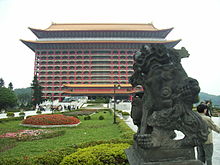Grand Hotel (Taipei)
The Grand Hotel Taipei (Chinese 圓 山大 飯店Yuánshān Dà Fàndiàn ) is located in the Zhongshan district of the Taiwanese capital Taipei . Operated by the Duen Mou Society , a semi-governmental non-profit organization , the fourteen -story building is a landmark of Taipei and one of the most representative hotels in Taiwan. Since its establishment in 1952, it has been visited by numerous well-known international personalities.
location
Located in Zhongshan District in the center of Taipei on the hill Yuanshan near the Keelung River of subway stations Yuanshan and Jiantan .
history
After its defeat in the Chinese Civil War and its withdrawal to Taiwan, the Kuomintang government lacked a five-star hotel to accommodate high-ranking foreign guests. To remedy this shortcoming, a planning committee was formed under the leadership of First Lady Song Meiling to organize the construction of a luxury hotel on Yuanshan Hill in Taipei. Until then, the Great Shrine of Taiwan , a Shinto shrine from the time of Japanese rule, had stood on the site, the ruins of which were demolished for the construction of the hotel. The architect Yang Cho-Cheng was commissioned with the construction .
The hotel opened in May 1952 and has been continuously expanded since then. A swimming pool, a tennis court and a club hall (1953), the Golden Dragon Pavilion and the Golden Dragon Restaurant (1956), the Jadephönix Pavilion (1958) and the Chi-Lin Pavilion (1963) were set up. In 1968 the hotel was named one of the ten best hotels in the world by the American magazine Fortune . On the national holiday of the Republic of China (October 10) in 1973, the entire construction was finally declared finished. In the course of time numerous important international personalities have made guest appearances, including some incumbent and former heads of state.
In 1995, a fire broke out on the hotel's roof during renovation work. The roof and the upper floors of the building were destroyed because the ladders and pumps of the fire brigade did not reach that high. After three years of renovation work, the entire building was opened to the public again in 1998.
An offshoot of the Grand Hotel opened in 1957 on the banks of the Love River in Kaohsiung , Taiwan's second largest city. In 1971, the Grand Hotel Kaohsiung moved to Chengching Lake in Kaohsiung's Niaosong District .
architecture
Since the hotel is used to accommodate high-ranking international guests of the Republic of China and should therefore appear representative, the building was built based on the architecture of traditional Chinese palaces. With a height of 87 m, the main building is one of the tallest Chinese-style buildings in the world and was the tallest building in Taiwan from 1973 to 1981.
On the outside, the many vermilion columns and the curved roof testify to the traditional Chinese style, while inside the rooms are decorated with numerous Chinese art objects, wall coverings, paintings and sculptures. A motif that recurs with great frequency is the Chinese dragon . Other common motifs are Chinese lions and the plum blossom ( national flower of the Republic of China).
Each of the eight guest floors is decorated in the style of different dynasties from Chinese history . There are a total of 490 rooms, most of which have a good view of the city of Taipei. The most expensive rooms are in the Presidential Suite , which contains items from the legacy of President Chiang Kai-shek and his wife. The hotel also has a number of lecture halls and conference rooms that are regularly used for national and international events. Three restaurants take care of the physical well-being.
Underground tunnels
A special feature of the hotel are the underground passages under the building, the existence of which only became public knowledge after the fire in 1995. The two tunnels (total length approx. 180 m) lined with reinforced concrete and equipped with stairs and lighting were intended to serve as bunkers and escape routes in the event of an air or nuclear attack . The secret exits of the tunnels leading to nearby parks are camouflaged with concrete slabs and have remained undiscovered for decades. The underground passages are usually only opened to visitors on special occasions.
Trivia
- After the fire disaster of 1995, the two dragon heads on the roof of the building, which were previously facing outwards, were rotated 180 ° and are now facing inwards to protect the hotel from renewed fires (according to Chinese beliefs, kites bring water and rain ).
- The hotel is featured in the 1994 film Eat Drink Man Woman directed by Ang Lee .
- One level of the Alpha Protocol video game is set in the Grand Hotel.
- In an episode of the series Ghost in the Shell: SAC 2nd GIG, Major Motoko Kusanagi stayed at the Grand Hotel.
gallery
Individual evidence
- ↑ Taiwan's Grand Hotel welcome for Chinese visitors , BBC News, Jan. 23, 2010
- ↑ Skyscrapers.cn - List of tall buildings in Taiwan ( Memento of the original from November 9, 2015 in the web archive archive.today ) Info: The archive link was automatically inserted and not yet checked. Please check the original and archive link according to the instructions and then remove this notice.
- ↑ http://www.chinapost.com.tw/editorial/taiwan-issues/2010/09/25/273824/Whats-in.htm
Web links
- Official website (English).
Coordinates: 25 ° 4 ′ 43.2 " N , 121 ° 31 ′ 34.9" E









